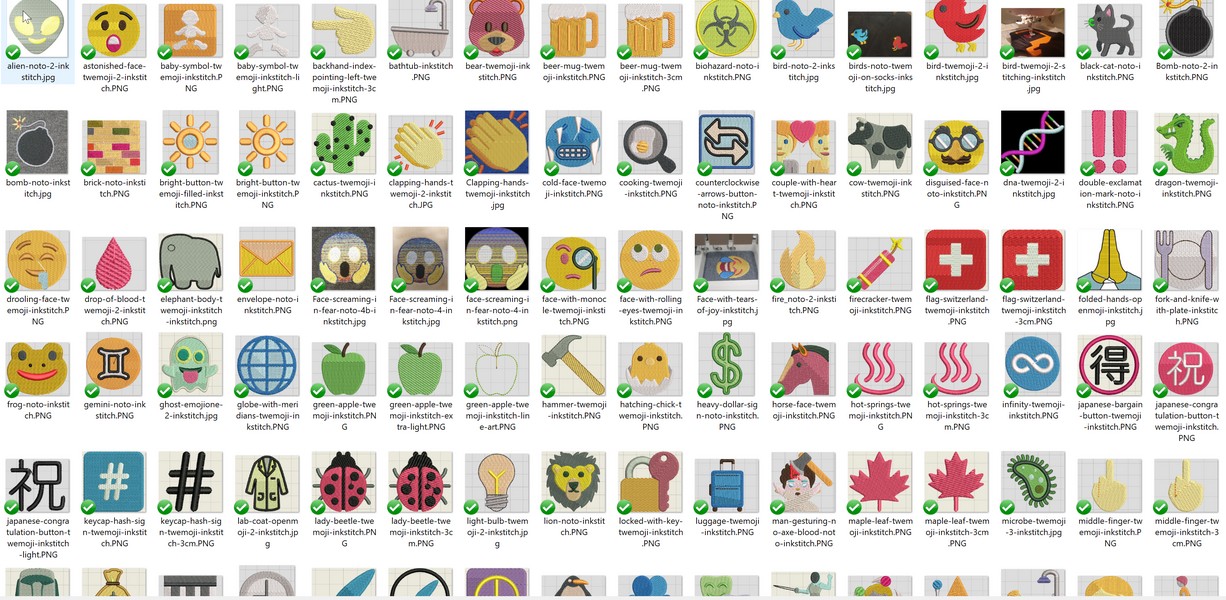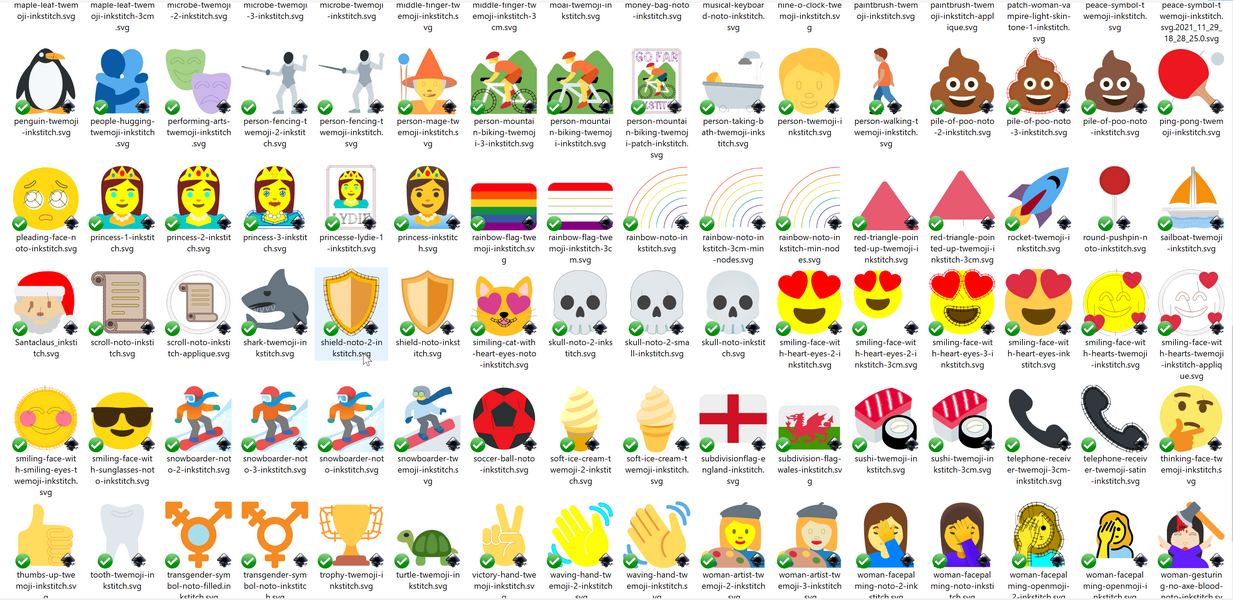Emoji Embroidery Project: Difference between revisions
m (→Pictures) |
mNo edit summary |
||
| Line 24: | Line 24: | ||
== Participants == | == Participants == | ||
This project is led by Daniel K. Schneider ([http://faclab.ch FacLab Université de Genève] and [http://arbores.tech/ Arbores Tech SARL]) and | This project is led by Daniel K. Schneider ([http://faclab.ch FacLab Université de Genève] and [http://arbores.tech/ Arbores Tech SARL]) and Lydie Boufflers ([http://tecfa.unige.ch TECFA]). It is supported by the [http://faclab.ch FacLab University of Geneva] and its infrastructure. | ||
== Using the Emoji Embroidery Project Library == | |||
First, let's remember that the files are available under the https://creativecommons.org/licenses/by-nc-sa/4.0/ Attribution-NonCommercial-ShareAlike license. So you can use them for non-commercial purposes and you must replicate the same license when you redistribute a file or a derivative of a file. | |||
=== Dimensions === | |||
By default a design has a maximum height or width of 4.5cm. This allows you to embroider it with a small 5x5cm frame and cover a small hole. Some simple designs are also available in 3x3cm. | |||
=== File type === | |||
* <code>.SVG</code> SVG source file, slightly adapted. | |||
* <code>*-inkstitch*.SVG</code> [[InkStitch]] design file. You can use it as is, change just parameters (including density and offsets), or adapt it | |||
* <code>.DSG</code> [[Stitch Era]] design file, semi-professional software with a very good price/performance ratio | |||
* <code>.PES</code> Machine embroidery file for Brother embroiderers (You can use conversion software to translate it to another brand compatible format) | |||
* <code>.DST</code> Machine embroidery file for Tajima embroiderers. Most reliable format, but without color information | |||
* <code>.PNG</code> Usually a simulation is created with TrueSizer software | |||
* <code>.JPG</code> Usually a photo of an embroidery (often just a simulation) | |||
=== File name === | |||
The file name starts with the official UniCode name ([https://unicode.org/emoji/charts/emoji-list.html Emoji List, v14.0, unicode.org]). Then comes other information, like the font name (especially Noto and Twemoji), "inkstitch" (if made with InkStitch), size (if different) etc. | |||
About like this: | |||
Uni-code-name - Fontname - (inkstitch) - Extras - Size | |||
Examples: | |||
: scientist-twemoji-inkstitch.svg | |||
: avocado-twemoji-inkstitch-3cm.svg | |||
: backhand-index-pointing-left-twemoji-inkstitch.svg | |||
=== Usage === | |||
'''Dense design''' | |||
Most of the patterns are set with a strong density (5 lines/mm = 0.2mm distance between the threads). This is to cover a hole well. Satins and fillings often have a strong compensation. We also overlay the embroidery objects. | |||
You can embroider these designs directly on a garment, but we advise to do a test because (1) some designs have not been tested and (2) the designs are optimized for an unstable fabric like sweaters. | |||
'''Appliqués and Patch''' | |||
The [http://tecfa.unige.ch/guides/embroid/emoji/AAA_EMOJIS/AA_PATCH_APPLIQUE/ AA_PATCH_APPLIQUE] folder includes templates for creating patches and appliqués. | |||
{| class="wikitable" | |||
|+ | |||
!Type | |||
!size | |||
!fabric size | |||
!size emoji | |||
|- | |||
|Round patch | |||
|62mm | |||
|62mm | |||
|4.5cm (standard) + very short lettering | |||
|- | |||
|Round patch | |||
|64mm | |||
|62mm | |||
|4.5cm (standard) | |||
|- | |||
|Square patch | |||
|62mm | |||
|62mm | |||
|4.5 (standard) + small lettering | |||
|- | |||
|Round patch | |||
|46mm | |||
|46mm | |||
|3cm | |||
|- | |||
|Round patch | |||
|48mm | |||
|46mm | |||
|3cm | |||
|} | |||
[[image:Applique-vs-patch-emoji.jpg|thumb|none|600px|To the left: appliqués 48mm (wider border). Right: 46mm patch (patches, thinner border)]] | |||
Translated with www.DeepL.com/Translator (free version) | |||
== Pictures == | == Pictures == | ||
Revision as of 11:58, 7 December 2021
Introduction
See also: Emoji Embroidery Project (en français)
The Emoji Embroidery Project aims to create a capability to create emoji embroideries.
So far, documentation only exists in french (in the sister wiki) It includes:
- A database of digitized emoji, reusable for non-commercial purposes (expanding, yet to be documented): fr:Liste des emojis à broder
- Tutorials on how to use them (to be done)
- Tutorials on how to create your own scans from "free" emoji font designs: fr:InkStitch - broder un emoji and fr:Stitch Era - broder un emoji
- Activities such as the fr:atelier upcycling avec des broderies émoji
- Educational material that makes use of emoji designs, for example the fr:Cours d'initiation à la broderie numérique (FacLab UniGE) course.
- A technical and conceptual introduction to fr:Emoji (to be refined).
Objectives:
- To bring embroidery to a wider audience.
- To contribute to sustainability (by showing an easy path to upcycling)
- Contribute to digital embroidery education (emoji are relatively easy objects to digitise)
- Spreading the idea that digital embroidery is an interesting medium to develop digital skills, making skills and some soft skills.
Participants
This project is led by Daniel K. Schneider (FacLab Université de Genève and Arbores Tech SARL) and Lydie Boufflers (TECFA). It is supported by the FacLab University of Geneva and its infrastructure.
Using the Emoji Embroidery Project Library
First, let's remember that the files are available under the https://creativecommons.org/licenses/by-nc-sa/4.0/ Attribution-NonCommercial-ShareAlike license. So you can use them for non-commercial purposes and you must replicate the same license when you redistribute a file or a derivative of a file.
Dimensions
By default a design has a maximum height or width of 4.5cm. This allows you to embroider it with a small 5x5cm frame and cover a small hole. Some simple designs are also available in 3x3cm.
File type
.SVGSVG source file, slightly adapted.*-inkstitch*.SVGInkStitch design file. You can use it as is, change just parameters (including density and offsets), or adapt it.DSGStitch Era design file, semi-professional software with a very good price/performance ratio.PESMachine embroidery file for Brother embroiderers (You can use conversion software to translate it to another brand compatible format).DSTMachine embroidery file for Tajima embroiderers. Most reliable format, but without color information.PNGUsually a simulation is created with TrueSizer software.JPGUsually a photo of an embroidery (often just a simulation)
File name
The file name starts with the official UniCode name (Emoji List, v14.0, unicode.org). Then comes other information, like the font name (especially Noto and Twemoji), "inkstitch" (if made with InkStitch), size (if different) etc.
About like this:
Uni-code-name - Fontname - (inkstitch) - Extras - Size
Examples:
- scientist-twemoji-inkstitch.svg
- avocado-twemoji-inkstitch-3cm.svg
- backhand-index-pointing-left-twemoji-inkstitch.svg
Usage
Dense design
Most of the patterns are set with a strong density (5 lines/mm = 0.2mm distance between the threads). This is to cover a hole well. Satins and fillings often have a strong compensation. We also overlay the embroidery objects.
You can embroider these designs directly on a garment, but we advise to do a test because (1) some designs have not been tested and (2) the designs are optimized for an unstable fabric like sweaters.
Appliqués and Patch
The AA_PATCH_APPLIQUE folder includes templates for creating patches and appliqués.
| Type | size | fabric size | size emoji |
|---|---|---|---|
| Round patch | 62mm | 62mm | 4.5cm (standard) + very short lettering |
| Round patch | 64mm | 62mm | 4.5cm (standard) |
| Square patch | 62mm | 62mm | 4.5 (standard) + small lettering |
| Round patch | 46mm | 46mm | 3cm |
| Round patch | 48mm | 46mm | 3cm |
Translated with www.DeepL.com/Translator (free version)
Pictures
Emoiji-sample-pics-2021-12-05.png Une liste d'images de simulation pour Ink/stitch
Emoiji-sample-svg-2021-12-05.png Extrait de la liste Ink/Stitch fichiers design SVG



